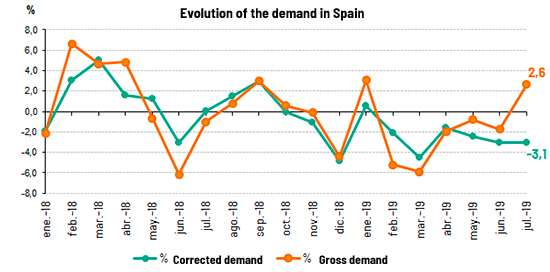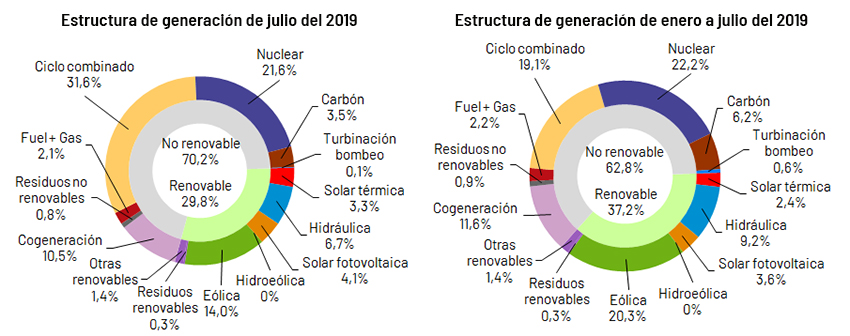We are a global operator of essential infrastructure
- Almost 30% of the total generation in Spain in July came from renewable sources and more than half of the total was generated using technologies that produce zero CO2 emissions.
- Demand on the Balearic Islands increased 5.4% compared to the same month last year.
- Renewable generation on the Canary Islands produced 24% of the electricity demanded in the archipelago.
The demand for electrical energy nationwide in the month of June is estimated at 24,283 GWh, 2.6% higher than that registered in the same month last year. After having factored in the influence of seasonal and working patterns, electrical energy demand fell 3.1% compared to July 2018.
In the first seven months of 2019, the demand for electricity is estimated at 155,105 GWh, 1.4% less than in 2018. Again, after having factored in the influence of seasonal and working patterns, demand for electricity is 2.3% lower than that registered in the same period last year.

During the month of July and according to estimated data, generation coming from renewable energy sources represented 29.8% of the total production. 51.5% of electricity generation during the month was obtained using technologies which produce zero CO2 emissions.
With information available as at the time of this press release, wind energy generation in July reached 3,330 GWh, 29.3% up on the same period last year, and accounts for 14% of the total production in Spain.

Demand for electrical energy in the peninsular electricity system also increases by 2.6%.
Demand for electrical energy in the peninsular electricity system in the month of July is estimated at 22,768 GWh, 2.6% higher than that recorded in the same month last year. After having factored in the influence of seasonal and working patterns, electrical energy demand fell by 3.3% compared to July 2018.
In the first seven months of 2019, the demand for electricity on the Spanish Peninsula is estimated at 146,295 GWh, 1.5% less than in 2018. Again, after having factored in the influence of seasonal and working patterns, the demand for electricity is 2.5% lower than that registered in the same period last year.
During July and according to current estimated data, 30.7% of the peninsular generation came from renewable energy sources and 53.7% was obtained using technologies which produce zero CO2 emissions. Furthermore, wind energy generation in July stood at 3,172 GWh, a figure that is 27.8% higher than in July last year and contributed 14.2% to the generation mix.
Demand for electrical energy increases in the Balearic Islands and in the Canary Islands
In the Balearic Islands, the demand for electricity in July is estimated at 722,438 MWh, 5.4% higher than that recorded in the same month last year. After having factored in the influence of seasonal and working patterns, the figure increased by 1.3% with respect to July 2018. In the first seven months of 2019, the demand on the Balearic Islands is estimated at 3,506,632 MWh, which is 0.8% more than in the same period in 2018.
Coal-fired generation, with 33.3% of the total, was the leading source of electricity generation in the Balearic Islands. Renewables and those technologies that produce zero CO2 emissions accounted for 5.2% of the total generation on the Balearic Islands.
With regard to the Canary Islands, the demand for electricity is estimated at 753,309 MWh, 0.8% lower than that registered in July 2018. After having factored in the influence of seasonal and working patterns, the figure falls 1.5% compared to that of the same month last year. From January to July, demand on the Canary Islands is estimated at 5,064,385 MWh, showing an increase of 0.2% compared to the same period in 2018.
In the month of July and according to estimated data, combined cycle was the leading technology in the Canary Islands’ generation mix, with a contribution of 34.8%. Renewables and those technologies that produce zero-emissions accounted for 24% of the generation on the Canary Islands.
Visita nuestro Informe de balance diario para más información sobre los sistemas nacional, peninsular, balear y canario a cierre de julio.














